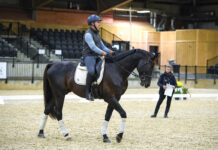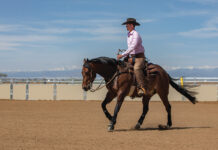We’ve all seen trail-string horses tied to a hitching rail with their legs cocked and heads nodding in the sunshine—no anxious behavior or antics.
The Value of Preparation
Training a horse to be “tied hard”—putting a knot in the rope, even a quick-release—may take weeks. Preparation is imperative. You don’t want to take a horse that has no preparation, tie him hard and let him fight it out. This has been customary in the past, and only some horses get through it successfully. A horse may become so frightened that he is dangerous. He can hurt his neck and spine, break lead ropes and run away in a panicked state, pull posts out of the ground, and even flip over and seriously injure himself or people around him. Once he develops this kind of pullback response, it’s very hard to change. Plus, it makes the horse untrusting.
There is no reason to have these kinds of experiences. A few simple, noncombative steps can make tying lessons easy for both you and your horse.
Don’t Rush It!
First, your horse needs to yield off the halter when led in-hand so that he understands the proper response to poll pressure from the halter. He should flex his neck muscles, yield his head down willingly, and come forward softly.
By simply leading your horse, you can tell if he has a pullback response: When the halter becomes tight, he gets that untrusting look in his eye, lifts his head and doesn’t come forward freely. Obviously, if he can’t be led without concern, he’s certainly not ready to be tied.
Back it Up
When your horse leads willingly, teach him to back without hesitation. When backing, stop your own motion and then ask your horse to stop by holding your hand steady on the lead rope as though it were a fence post. When the rope becomes tight and the halter places pressure on your horse’s poll and head, observe what he does. If he stops and immediately balances forward, he passes the test.
If he puts his head up and pulls back, he’s not ready to be tied because he’s not willingly coming from a backward motion to an immediate forward stop. When this happens, the halter becomes tight and he rushes back even more. That’s the biggest issue you want to avoid.
Tying Me Softly
When your horse can be led forward and backward in a quiet and willing manner, the next step is to tie him “soft.”
“Tying soft” means wrapping the lead three times around the post (without tying it) so that if your horse does pull back, he’s not under the full confinement of being tied hard and fast. With a soft tie, the wrap on the post will slip and come undone. You should always be present during these short introductory sessions so you can handle any situation that may arise. If a pullback happens, obviously the horse needs more leading and yielding preparation before being soft-tied again.
Timing and Setting
Practice soft-tying where your horse is most comfortable, whether it’s a stall or a spot where other horses are tied. At this point, making the mistake of taking him away from his comfort area may lead to a wreck.
Don’t teach tying when your horse is fresh and vigorous. Lessons should come at the end of training sessions when he’s tired. Sometimes I’ll tie a horse within reach of a small amount of grain in a bucket or a few handfuls of hay in a hay net so he equates being tied with something rewarding. When food is offered, often the horse doesn’t even realize he’s being tied. This initial tying lesson is only for a short time (10 to 15 minutes), and it’s only when I’m present so that I can intervene if necessary.
Dealing with Anxiety
If your horse is tied soft, has a companion within sight, and is still anxious and thinking about pulling back, simply unwrap the lead from the post and move him until he relaxes. Then wrap the lead only once around the post and back to you. Encourage your horse to come forward just a step through gentle pressure on the rope. Each time you bring him forward, give him a rub on the head and let him rest there. Then release the wrap and back him up. Repeat this until he’s no longer concerned about being soft-tied to the post and willingly moves forward from the pressure coming from the direction of the post.
When to Tie Hard
Once your horse is comfortable being tied soft, complete at least 30 sessions doing just that. As the sessions progress, assess his response by taking his companion horse away, if you’re using one. In another session, judge your horse’s progress by soft-tying him when he’s a bit fresh and wants to go somewhere. His demeanor will let you know if he’s ready to be tied hard or needs more time and lessons.
Pawing
In the beginning of training, pawing is actually a good sign. When a young horse paws while tied soft (for instance, after 30 sessions and being taken away from the companion horse), it means he would like to leave but knows he can’t. He knows he can’t push through the rope or pull his way to freedom. Pawing is a sign that he realizes he’s stuck there and is truly tied.
Pawing is also a signal that you need to do more work. Rather than letting your horse dig a hole to China, untie him and move, move, move him before re-tying him. Repeat this for several sessions until he likes the idea of standing still while being tied.
Post Oats
Once I start these progressive tying lessons, it becomes a daily routine, sometimes for months. The successful result is that when I tie a horse to a trailer—or wherever I need to saddle and groom him—he stands still, cocks a leg and sleeps. I learned to call it giving the horse “post oats,” meaning that he appreciates the post just as much as he does oats. I’m not sure horses ever like being tied, but they do get very relaxed and settled as tying becomes more comfortable for them.
Tying Mistakes
- Tying at the wrong height. It’s ideal to tie higher than the withers; the higher the better. If your horse pulls back when tied high, he’s sitting down on his own weight. If the rope is tied level with or lower than his withers, he can pull more than his own weight and may get into a wreck.
Tying too long. You want to tie the rope short enough that your horse can’t get his head below his knees and get a foot over the rope, which is a dangerous situation.
Leaving him alone. Don’t tie your horse and then leave. And don’t tie him for hours at a time; only tie him for a few minutes during this initial process.
Tying to a rail and not to the post. Many times a rail will pull off. A horse can actually bolt with the rail attached to him, potentially resulting in significant injury and damage.
Tying to a single post out in the open. Tie to a post-and-rail fence that the horse can’t walk around, making the lead shorter with each trip around the post.
Not clearing the tying area. Keep it free of objects that could be stepped on, poke an eye, or catch the halter.
Using the wrong knot when tied hard. Learn a quick-release knot at HorseChannel.com/QuickRelease.
This article originally appeared in the February 2014 issue of Horse Illustrated. Click here to subscribe.







My mare is 18 years old leads beautifully, dead broke, loving, has never spooked and is just perfect in every way and will tie great if I’m right there, never offers to do anything, HOWEVER as soon as there is NO ONE around she will slip her halter and go for a walk, I now have a Tie line, neck belt and she has managed to slip that as well! she doesn’t panic or run but works at it until she is loose I have watched her from a window in the house where she doesn’t see me! if I tie her with a quick release she will untie the lead line and take off! any suggestions? she is a Houdini!
Great tips.
I have a 15-y/o gelding who is very herd-bound. When I take him away from the herd but still close enough to see/hear/smell the herd, and try to tie him, he will pull until he breaks his halter and then runs back to the fence closest to where the herd is. He has broken every halter I had, both nylon and leather. He will pull until the halter itself breaks, literally snaps in two where it fits behind his ears. I have to leave him in the pasture all the time – there are no stalls available where I board him, and a long wait list for any stalls that come open.
On the other hand, I have taken him on many overnight trail rides and he does great being staked out with strange horses. I can leave him on a long enough line that he can get his head down to eat grass, and he never gets tangled in his rope. I have even staked him out with a 25’ long line, and he did great overnight, not pulling or getting tangled (I got up throughout the night to check on him until I was sure he would be fine). I have done this for many years and he has never gotten into trouble on a long line.
It is very hard to catch him in the pasture when he sees me coming with a halter and lead rope. I try to hide them by hanging them around my neck and letting them hang behind me, but he is not fooled. He will only come up at his regular feeding time, but will leave his food and run away if I try to actually catch him.
If I try to lead him around, he will pull away from me and run back to his herd. I have fibromyalgia and do not have much arm strength, and he knows he can always get away from me.
However, once I do catch him and saddle him up, I have no trouble riding him away from his herd and bringing him back. However, one time I had ridden him past the gate to the pasture twice and was trying to ride past a third time when he suddenly swerved and jumped the fence, about 3.5’ high, from only 3-4’ away from it and from a nearly standing start. (I got knocked off by a tree branch).
Can you give me any suggestions on how to stop him pulling when tied close enough to his own herd? And also to be able to ride him past the gate as many times as I want without him getting away from me?
I appreciate any advice you can give me.
my horse likes to pull when she is tied up. I have no idea how to get her to stop before she hurts me, herself or anyone else. any ideas? please help.
I had a mare that would break halters, too, because before I got her, someone let her do it. I brought a no-pull halter, that has an extra rope/strap which goes behind the ears, (poll area), and then feeds down through the halter to the tie ring, so when she pulled back, she was actually hurting herself. The halters do not break so easily, but she did break one.
good tips!
Really useful article. Just three comments:
1. Rope halters are not for tying up, even with a snap. The weight of a horse on that thin cord behind the ears puts a lot of pressure in one spot.
2. On that particular fence, I don’t think the coils would unwrap, since they will tighten and catch on the horizontal plank.
3. Companion horse is best tied far enough away so if the horses move their back ends toward each other, both are out of range of a kick by the other.
I have a 12 year old mare who is capable of standing tied for a long period of time, but if she gets startled she pulls back hard. She has broken a few lead ropes and halters but is currently in an unbreakable one (the snap is a twist latch and it’s a very strong rope) and a heavy duty rope halter. But once something has scared her and she’s pulled back at a location she will try everytime she realizes it’s a “hard tie” usually once she starts pulling I can say “dusty quit that’s enough” in a stern voice and she will pop forward. But she stands wonderfully soft tied or ground tied which isn’t always an ideal solution. Is their any way I can stop her from pulling back when hard tied when that’s the only thing she has an issue with? I really don’t want her to hurt herself but I need to be able to tie her in certain situations.